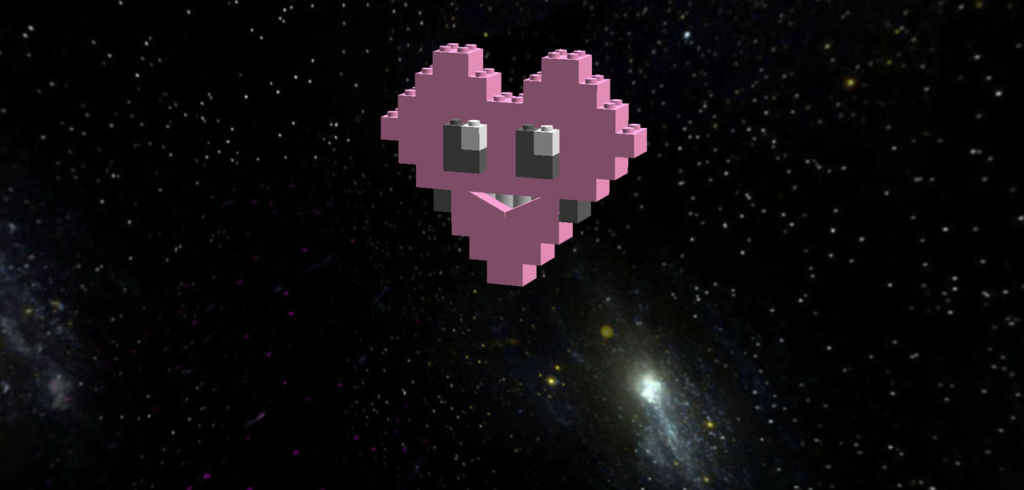What you’ll learn:
How to re-create Lego shapes from a tangram 3D puzzle image.
Key takeaways:
Exercising our visual-spatial reasoning skills can be fun.
 I love 3D puzzles for kids, especially when we find ways to use 3D puzzles without having to actually buy the specialty 3D puzzles for kids. Lots of kids have a box of Lego bricks at home, so this project is easy to source- just print out our free Lego tangram puzzles, open the bin, and create!
I love 3D puzzles for kids, especially when we find ways to use 3D puzzles without having to actually buy the specialty 3D puzzles for kids. Lots of kids have a box of Lego bricks at home, so this project is easy to source- just print out our free Lego tangram puzzles, open the bin, and create!
This set of 3D puzzles for kids is really focused on making fun hearts since Valentine’s day is just a little bit away. One of my favorites is the Lego brick heart that has a window to add in a little photo. This makes a super cheap present for mom and/or dad that also teaches kids a lot of visual-spatial reasoning skills.
Project Ingredients:Red Lego Bricks
LEARNING ABOUT THE IMPORTANCE OF VISUAL SPATIAL REASONING
What are Tangram puzzles?
 Tangram puzzles are an ancient Chinese puzzle that consists of drawings and a set of seven shapes: 5 right triangles (2 large, 1 medium, and one small), a square, and a parallelogram. These shapes can be combined to create simple shapes, like a very large square, or more complex shapes like the tangram man on the left.
Tangram puzzles are an ancient Chinese puzzle that consists of drawings and a set of seven shapes: 5 right triangles (2 large, 1 medium, and one small), a square, and a parallelogram. These shapes can be combined to create simple shapes, like a very large square, or more complex shapes like the tangram man on the left.
These puzzles for kids are great because of the simplicity of them, as well as how they engage kids in visual-spatial reasoning.
What are some kids tangram puzzles?
The easiest way for kids to play with tangrams are for them to free build, just as the easiest way for kids to play with Lego bricks is to free build. This allows kids to experiment with how the shapes can combine into new shapes, how the area of the shape and the outline of the shape can be related, and how flipping a shape can change the outcome.
As kids gain a keener sense of how the shapes can fit together they can begin to engage in the beginning tangram puzzles. A tangram set usually comes with a deck of puzzles that get increasingly difficult.
How do tangram puzzles for kids teach visual-spatial reasoning?
Tangram puzzles challenge kids to visualize, in their mind’s eye, how to create a target shape. They then learn, through experimentation and building, if that method would work. Kids can then rotate, move, and flip the shapes to try again, and again, and again. In this way, it is continually helping kids visualize how shapes will fit together, and then test their visualization.
Do 3D puzzles for kids help them learn math?
That is a tricky question because how kids learn is a tricky question. However, studies show that working on spatial reasoning before looking at math problems significantly boosts kids performance. This is likely because it primes the brain to be thinking logically. The kids didn’t need a whole lot of time to work on spatial reasoning puzzles to boost their performance either – just one 20 minute session was included in the study.
Why is spatial reasoning important?
With all this talk about 3d puzzles and tangram puzzles you might be wondering, why is spatial reasoning important? Doing better on a math test isn’t necessarily life-changing. In fact, even the ability to recall math facts isn’t necessarily imperative to future success. I have a Ph.D. in Physics (with my studies being in molecular biophysics), and for decades of my life, I still used my fingers for simple math. I don’t think using my fingers inhibited my success on passing my qualifiers.
So, if we aren’t looking at test scores, why is spatial reasoning important? I’ll be honest, I’m not a huge fan of test scores anyhow, but having the ability to imagine something in your mind’s eye, deconstructing and reconstructing it, walking around it mentally, those are all enormously useful, and in ways that don’t just help you calculate simple math faster.
For example, a mechanic must visualize how parts will fit together, an astronomer must visualize the effects of the distances of stars and exoplanets, a chemist must visualize the importance of shapes and orientations of molecules, a vet or doctor must visualize what is happening when looking at a xray. All of these tasks use spatial reasoning.
Why combine Lego bricks and Tangram puzzles for kids?
Lego bricks and tangram puzzles are both building toys that help kids learn about spatial reasoning. In this valentine’s activity, they can combine the two to learn a lot of spatial reasoning while building cool structures that you can easily display around the house – which you can’t do with regular tangrams.





The 3D puzzle ( LEGO tangrams) download button isn’t working properly . When clicked it’s opening the learn binary pdf. Such a great and fun way to creat an amazing puzzle otherwise . Very excited to learn. Please fix the download link. Thank you.
Oh no! THanks so much for letting me know, just fixed it for you!